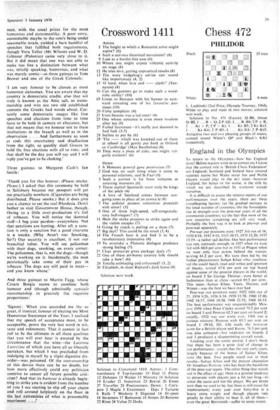Chess 472
PHILIDOR
L. Loshinski (2nd Prize, Olympic Tourney, 1964). White to play and mate in two moves; solution next week.
Solution to No. 471 (Eason): Q-B6, threat Q-B2. 1 B x Q; 2 P-Q5. I R-B4; 2 P x R. 1 . . . Kt x P; 2 P x Kt. 1 ... Kt-B5; 2 Kt-Kt3. I . . . Kt-K6; 2 P-B3.-1 . . . Kt-K8; 2 P-Kt5. Attractive two and two pleasing groups of mates, centred round White's QP and Black's KKt respectively.
England in the Olympics
To return to the Olympics—how has England done? Before readers write in to correct me I know that the correct title is 'British Chess Federation' not England; Scotland and Ireland have entered separate teams but Wales never has and Welsh players would play in the BCF team—however England, for better or for worse. is the title by which we are described by everyone except ourselves.
It is difficult to assess the relative merits of our performances over the years; there are three complicating factors: (a) the gradual increase in the total number of countries; (b) the formidable rise in strength over the post-war years of all the communist countries; (c) the fact that most of the new countries competing are still very weak. Probably the best way is to look at pre-war and post-war separately.
Pre-war our positions were: 1927 3rd out of 16, 1930 8/18, 1931 9/19, 1933 10/15. 1935 12/20, 1937 13/19—a rather sad decline. Our best performance was not, curiously enough, in 1927 when we were 3rd with 60.8 per cent but in 1931 at Prague when we were only four points behind the winner, scoring 61.2 per cent. We were then led by the Indian phenomenon Sultan Khan who, uneduca- ted (he could barely read and write) and ignorant of theory, scored 67.6 per cent on top board against some of the greatest players in the world; on board 3 Sir George Thomas—even better at badminton than at chess—scored 69.5 per cent. This team—Sultan Khan, Yates, Thomas and Winter—was the best we have ever had.
Post-war our positions were: 1952 16th out of 25, 1954 9/26. 1956 8/34, 1958 11/36, 1960 12/40, 1962 14/37, 1964 18/50, 1966 21/52, 1968 16/53. The best performance was unquestionably Mos- cow 1956 when Peter Clarke scored 79.2 per cent on board 5 and Penrose 62.5 per cent on board 2; equally, 1952 was our worst ever. 1968 was a curious mixture; Penrose with 83.3 per cent on board 1 (W10, D5, LO) made the best-ever score for a British player and Keene. 76.5 per cent was also unbeaten—but weakness on boards 2 and 3 produced a disappointing overall result.
Looking over the entire period, 1 don't think that there has been a great deal of change in our performance—except that the very early years, largely because of the bonus of Sultan Khan, were the best. Two people stand out in their results—Sultan Khan and the present champion Dr Jonathan Penrose, who has been the backbone of the post-war teams. The other thing that stands out is the effect of age; there is a general tendency to persevere with players just a bit too long—to
select the name and not the player. We are better now than we used to be, but there is still room for
improvement; every year over forty-five is a heavy extra weight and though players vary greatly in their ability to bear it, all of them— even the great Botwinnik—suffer to some extent.














































 Previous page
Previous page